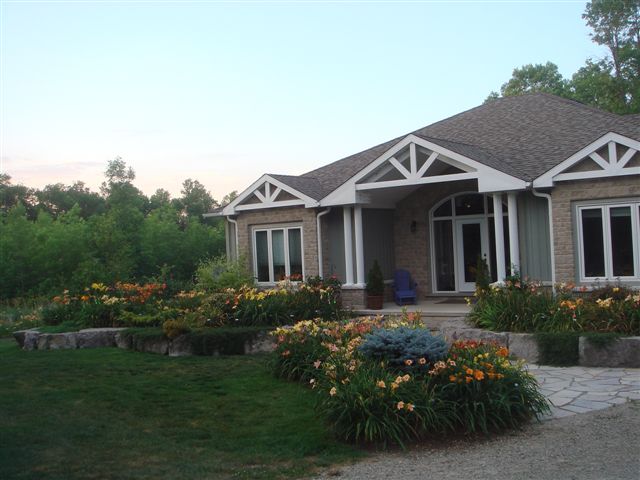

Welcome to Hillside Daylilies and thanks for visiting! While I've always had daylilies in the garden, I first started to seriously collect and hybridize them in 2000. At the time our previous property was on the side of a very steep hill which was part of a gravel moraine on the outskirts of the city of Guelph Ontario. Raised bed gardens tiered up the hill were the norm there as was a pick and pry bar any time I wanted to dig a hole as a shovel could not penetrate the gravel base "soil".
In the fall of 2008, we purchased a vacant 2.5 acre lot in Puslinch Township about a 10 minute drive south from our former location. We arranged to have a modular home built on the property in the spring of 2009 but were only able to move here at the end of October due to a slow real estate market. As it was early September before we accepted an offer, I was unable to start to move plants until that time. I estimate that by early November I had moved and replanted nearly 2,500 daylilies plus some shrubs, other perennials and bulbs. Despite the late planting, everything survived!
I have been a member of the Ontario Daylily Society (ODS) and the American Hemerocallis/Daylily Society (AHS) since 2001. I am a past president of the ODS, continue to sit on the board of the ODS and have been the chair of the annual Can Am Daylily Classic for many years. I am a garden judge instructor for the AHS and have been the Regional Publicity Director for the AHS Region 4 which encompasses the northeast US states and eastern provinces of Canada. I have been a long-time seller of daylily seeds and occasionally plants on the Daylily Auction under the user ID of dwm. Feel free to check out my listings!
In terms of hybridizing goals, I am pursuing several different areas. From the beginning, I've been working toward creating true spotted daylilies, much like we see with spotted phalenopsis orchids which were a collecting obsession long before I got involved with daylilies. Twenty years later I am only now starting to see some progress in this area. That interest expanded into tetraploid striped and broken colour daylilies. Toothy edged daylilies have also been a passion and I have tried to use different genetic lines than many others, particularly favouring those of Brother Charles Reckamp whose plants I had long collected. Another focus has been extra early blooming tetraploid daylilies, trying to increase the size and colour selection of plants that will bloom with, or even before, the commonly seen Stella D'Oro. I started working with tetraploid cristates (blooms with extra tissue on their surface of the petals) as a result of a seedling that became my intro Kendra Marie. Cristates are a new developing area of daylily breeding. I'm also interested in tetraploid polymerous (blooms with more than the usual allocation of 3 petals and 3 sepals) as well as true white tetraploids.
As part of my focus on spots and stripes, I started to experiment with how to convert diploid daylilies into tetraploids in 2012. It is a complicated and time-consuming process that involves careful use of mutagenic chemicals and many of the treated plants either die in the process or remain unconverted. It usually takes 1-2 years to bloom any surviving plants at which time you can examine the pollen under a microscope to see if you have had any success. "Success" is a relative term in that very few plants are fully converted, many are chimeric (partially converted exhibiting both diploid and tetraploid pollen in various degrees) or they may be triploids (which are infertile) or remain unconverted as diploids. Every year I experiment a bit more, learn more and slowly make some progress. My first success came with the conversion of my Cherry Stripes, then later Pink Stripes and have had several others as well. Converting a diploid to tetraploid produces a unique plant that brings new genetics to the tetraploid gene pool and it is exciting to see what they might produce in breeding with them. However, using these new conversions has just expanded the number of breeding areas I'm working on contributing to what might appear as a lack of focus! As it is, I plant out between 4,000 - 5,000 seedlings annually and even then it is difficult to work within this limit with all the areas that I am exploring.
As daylily hybridizers we stand on the shoulders of those who have gone before us and hope to build upon their achievements and advances. I have been fortunate to have been mentored by three great local hybridizers who I also count as friends. Mike Georges introduced me to the madness of serious daylily collecting and breeding. Bryan Culver is the reigning dean of Canadian hybridizing and freely shares his opinions! Gil Stelter introduced me to the beauty of daylily species, historical cultivars and unusual forms. The four of us have had many lively discussions, road trips, garden tours and lots of fun. To them I owe a great debt of gratitude.

This page was last updated on 2021/07/05.